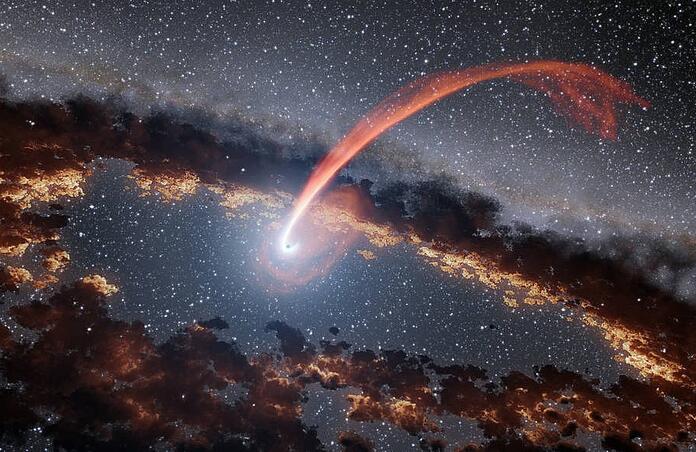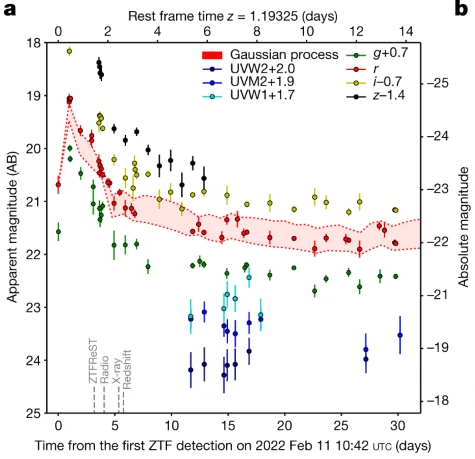Transient Flash Identified as Distant Tidal Disruption Event

Earlier this year, on the 2nd of February 2022, the Zwicky Transient Facility (ZTF) identified a flash within the optical waveband, with an apparent magnitude of ~20. Later named AT 2022cmc, it was, at the time, classified as a gamma ray burst (GRB) candidate. However, a more recent study, published on the 30th of November 2022, instead proposes the flash to have been caused by a tidal disruption event (TDE).
The transient event was identified when the ZTF Realtime Search and Triggering (ZTFReST) pipeline flagged the unusual behaviour of a target. Over a period of two days, it identified an unusually fast rise and fall in observed magnitude, warranting further investigation.

Apparent and absolute magnitude plot of the AT 2022cmc event following its discovery, in various photometric passbands. Peak brightness occurred at around two days. The lightcurve quickly plateaus after around 10 days. The plotted error bars show 1σ.
By analysing absorption spectra, the team concluded that the event was redshifted by z = 1.19325, which suggested it to be astonishingly distant. The papers explicitly calls out the unusually high peak x-ray luminosity, outputting a power in excess of 1041 W, which was approximately 100 times more powerful than any prior observed GRB. This was in addition to extreme luminosity variations, fluctuating by a factor of 500 within a few weeks. This is another property not typically attributed to GRBs. They noticed that these trends to be similar to the previously observed relativistic jets of Sw J1644+57, leading them to investigate this possibility. It was found that AT 2022cmc was in fact one the brightest ever observed tidal disruption event.
Tidal disruption events occur when a star approaches the tidal disruption radius of a supermassive black hole, succumbing to the tidal forces, tearing it apart. The stellar material accretes around and consequently orbits the black hole. However, in some cases, the stellar material is accelerated to relativistic speeds, being violently ejected from orbit. This emits vast quantities of electromagnetic radiation via synchrotron emission.

Image of AT 2022cmc taken by the Hubble space telescope within the visible spectrum.
While nowadays, TDEs are routine discoveries, supplying plentiful sources of analysis, AT 2022cmc is one of the most distant, and luminous cases to date. A typical TDE is visible to telescopes at maximal distance equivalent to a redshift of z = ~0.2 equivalent to a distance of approximately 8.44 x 108 pc. However, as mentioned, AT 2022cmc lies at a redshift of z = ~1.2, which is an order of magnitude further away than most TDEs, at 8.45 x 109 pc. This is because it is subject to the effects of Doppler boosting. This effect is caused by the relativistic velocities achieved by the ejected material, significantly raising the apparent luminosity of the target. This was compounded by the fact that our line of sight was almost in line with the jet’s ejection axis, estimated to be less than 1 °, further amplifying the doppler boost.
AT 2022cmc is in fact only the fourth ever identified TDE subject to the effects of Doppler boosting, with the last found all the way back in 2011. However, the study claims to be optimistic that this marks a change, as telescopes become more sensitive, we will be able to capture these events with higher frequency, and eventually conclusively explain the mechanisms by which TDEs cause these immense jets to be ejected.
--
Journal Source: I. Andreoni et al, A Very Luminous Jet from the Disruption of a Star by a Massive Black Hole, Nature Astronomy, 2022
D. Pasham et al, The Birth of a Relativistic Jet Following the Disruption of a Star by a Cosmological Black Hole, Nature Astronomy, 2022
Cover Image: NASA/JPL-Caltech
